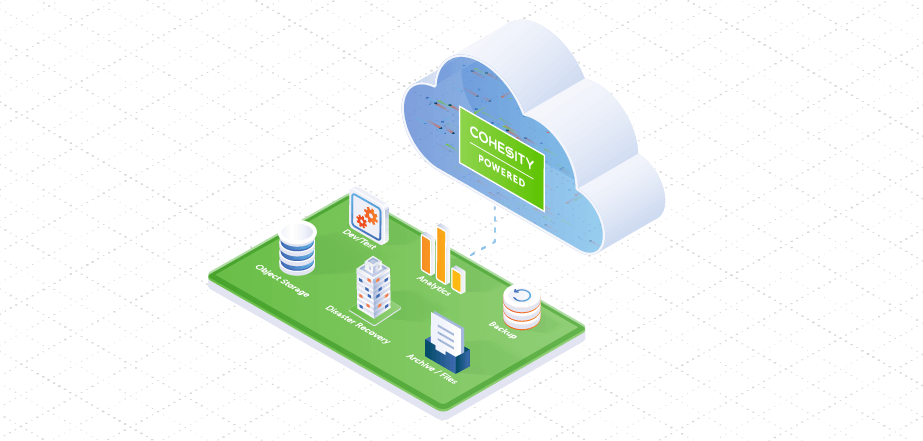About two years ago, we at Cohesity embarked on an exciting journey, partnering with service providers across the world (SPs) to deliver exciting and resilient data management services to customers.
We engaged with many cloud infrastructure providers, managed hosting providers, managed services providers and many other leaders in the cloud and IT services space, co-building offerings to improve customers’ business agility by simplifying data and application management. This blog is the first in a series focused on the milestones we have accomplished with our service provider partners, and how we continue to jointly innovate.
About our Service Provider Partners
Our partners deliver multi-cloud services on customer-premises, in co-location facilities, at their own data centers, or on leading public clouds, such as Amazon Web Services (AWS), Microsoft Azure, and Google Cloud Platform—in any or all combinations.
They offer managed IT services across private, public, or hybrid clouds, provide specific vertical expertise, help meet compliance needs, and provide differentiated offerings such as consulting or professional services, managed services, and integration capabilities.
Many of our partners have now standardized on Cohesity to deliver turnkey data management services to customers. These services include backup, disaster recovery, file and object services, archive, test/development, analytics, and custom services. When customers look for a managed IT service orlook to migrate to cloud, our service provider partners are a great bet..

The power of feedback and collaboration to improve the customer-journey
The results of our partnership with an accomplished list of SPs globally, which includes Expedient, QTS, Fujitsu, IOMART, Fundaments and many more are gratifying. They help Cohesity understand service-delivery requirements in intimate detail, and their feedback drives our roadmap and investments in our product.
For example, our partnership with Expedient went a long way in the creation and refinement of Cohesity Backup and Disaster Recovery partner services. Our collaboration enabled cloud-based data management that is easy to administer and scales on-demand. Quite fittingly, Expedient was bestowed the Cohesity’s Service Provider of the Year Award.
To begin Part 1 of this series of blog articles about our journey with SPs, I will share a sample of the “key” features we have delivered together through our many collaborations. These features enable, empower, and help SPs execute data protection services, while growing their revenues and managing the data management needs of their enterprise clients across hybrid clouds.
VMware ecosystem integrations
In collaborating with our SP partners, we have delivered numerous VMware ecosystem innovations. Here are just a few examples.
Support for VMware Cloud Director integration (starting from v.9.5, 9.5.1, 9.7, v.10.0 and now v.10.1)
Cohesity now offers VMware Cloud Director (VCD) plug-in support for v10.1 which extends our plug-in support to cloning VMs and vApps in Cloud Director.

Cloning VMs and vApps
Cohesity now makes it possible to clone VMware Cloud Director (VCD) VMs and vApps from backups, enabling test/dev use cases for SPs and their tenants.
Restore VMs to an alternate location’s storage profile
In the Cohesity platform, it is now possible to restore a VM to an alternate location by specifying the target VCD organization’s storage profile. All of these restores also are now instant, and this capability is supported for tag-based storage profiles.
Restore via file download
With the VCD self-service plug-in, Cohesity now enables SPs to restore files not only to their original locations, but also via web browser file download. This alleviates possible permissions and security issues that may sometimes interfere with restoring files to their original location.
Multi-tenancy support for vRA Workflows:
With vRealize Automation now enabled for multi-tenancy, SPs can now offer tenants self-service data protection workflows. Tenants with self-service vRA take more control of their own data protection workflows using Cohesity vRA Plugin.
VCD Plug-in: Cross launch to Cohesity Web GUI
In addition to the Cohesity multi-tenant vCD Cohesity plugin that is used to enable self-service data protection, SPs can now deliver more possibilities to their tenants. Tenants can cross-launch to the Cohesity UI from the vCD Plug-in and do backup and restore of other workloads, such as physical machines, databases, create file shares, test/dev clones. Through the in-context cross-launch integration feature, tenants are redirected to the Cohesity “tenant” organization login. To put it simply, this VCD is organization aware and maintains secure multi-tenancy while allowing all the workflows possible from the Cohesity Web GUI.

Restore to Cloud Director Storage Profile
Virtual machine storage profiles ensure that virtual machines use storage that guarantees a certain level of capacity, performance, availability and redundancy. With 6.5.1, when restoring to an alternate location in vCD, tenants will have the option to select the ‘storage profile option’ and ensure the storage profiles are applied to the restore.
Automation
Automation is extremely important to Service Providers, and Cohesity’s API-first architecture makes self-service automation simple. Over the last two years, we’ve completed many integrations with industry leading CI/CD tools like Ansibile, Terraform, ServiceNow, and Nagios

Get in-depth information on these integrations . And check out our various blogs on automations. Here’s a sample:
- Get Started with the Cohesity Ansible Module!
- Use ManageIQ with Cohesity Ansible Roles
- Cohesity Ansible Role Integration with Red Hat Ansible Tower
- Introducing Cohesity Integration with Terraform
- Use Webhooks to Manage Cohesity Alerts in ServiceNow
Networking Improvements
Our work with SPs has helped us solve extremely complex networking challenges. Here’s an example.

Cohesity Hybrid Extender, a result of consistent platform improvement driven by SP feedback, is now able to solve the challenges of maintaining secure, isolated networks while serving tenants with overlapping IP addresses. A proxy VM deployed on the tenant’s network provides secure communication between provider and tenant networks. As a service provider, you can offer data and apps management services to co-hosted tenants while improving cost, complexity, and security.
Simplifying DRaaS
Disaster Recovery as a Service (DRaaS) network configuration does not have to be complicated, as evidenced by this product improvement.
Disaster Recovery as a Service (DRaaS): Simplified Networking for Replication
Cohesity has simplified the networking configuration required for replicating from a tenant’s Cohesity cluster to a Service Provider’s Cohesity cluster. Now, tenants can deploy infrastructure with just a single, uni-directional (tenant to SP) TCP connection. No more firewall issues or networking reconfigurations. This results in significantly reduced operational complexity with Cohesity-powered DRaaS solutions.
Security
Security is paramount for SPs when delivering services on shared infrastructure platforms. And we’re proud of the direct feedback from many service providers that “Cohesity’s secure multi-tenant design” is the best they’ve seen in the industry.

In the last two years, we’ve built an incredible list of capabilities around security in the Cohesity Software Defined Platform. Check out our Security White Paper on our Cohesity website; it’s a great read. To summarize, I’ll highlights some of these key capabilities we’ve built;
- Secure Cluster Administration with:
- Authentication-server single sign-on
- Certification-based authentication
- Granular role-based access control (RBAC)
- User Audit Train
- Secure Multi-tenant Design with:
- Data encryption at rest and in-flight
- Integration with external key management systems and also AWS Key Manager Service
- Secure Data Management with:
- Datalock
- Legal hold
- Anti-Ransomware
- Secure Apps Ecosystem and Marketplace
- Compliance Standard and Certification – FIPS, Common Criteria (EAL2+ Certification), WORM (Sec 17a-4(f), ATO and more.
Reporting
Our collaboration with SPs has enabled us to deliver custom reporting.
Custom Reporting DB
Cohesity custom reporting is a PostgreSQL Database that has been natively built-in to the Cohesity DataPlatform to deliver reporting capabilities beyond the Self-Serve dashboard to create extensive customizable reports. A tenant can now create reports in multiple formats, across different areas like operations and planning, troubleshooting, forecasting, chargeback and billing, and compliance and auditing.
Custom Reporting App
The Cohesity Reporting app is an extension to the Custom Reporting DB that can be installed in a Cohesity cluster to automate ad-hoc data reporting. You can customize these reports to suit your business needs. The Reporting App has built-in reports that can be filtered, catering to most of the popular reporting business needs around compliance and audit, operations, and capacity management.
UX and User Dashboard
User experience is another area where our partnership with SPs inspired us to make major improvements.
Single Health Dashboard
A vastly improved, new user dashboard experience is now available. Now Service Provider admins will have a Single-Pane-of-Glass with a “Health” Dashboard view. In the System drop down menu you will see; Health related categories covering, Hardware (Disk, Node) Software (Backup and Restore) and Services (Remote Replication, Anti-Virus and much more).
DataPlatform (hardware)
Our hardware benefitted from our journey with our SP partners, as well.
Heterogeneous Cluster Support
You can now have up to two different models of HDD nodes together in the same Cohesity cluster. For service providers, this means:
- Choice and flexibility in hardware selection
- Future-proof investments
- Support for multi-vendor strategy or vendor transition
- Mix-and-match use case, with optimized nodes for cost
New Hardware Platforms
In addition to the Cisco and HPE Robo appliances, we have introduced a new Dell R640 ROBO appliance. This is a 1 Rack unit (RU), 1 node available in 2 options: 8TB Raw Capacity (2x 4TB drives) and 16TB Raw Capacity (2 x 8TB drives).
The availability of this appliance node means Service Providers have more options for delivering managed Backup and Disaster Recovery offerings to their Enterprise clients with dispersed branch offices.
Pay-as-You-Go Business Model
Our global network of managed service provider partners can now benefit from pay-as-you-go.
Consumption-Based Subscription Pricing for Service Provider Partners
As companies embrace consumption models to reduce capital costs, we’ve launched a pay-per-use subscription for our rapidly expanding global network of managed service provider partners.
The journey continues
These are just some of the key capabilities we’ve delivered to our SP community with our unique model of feedback and collaboration. We have some really exciting new announcements that are coming soon. I can’t wait to discuss some of these new developments in my next blog!
Interested in our SP partner program? Get the FAQ.
















